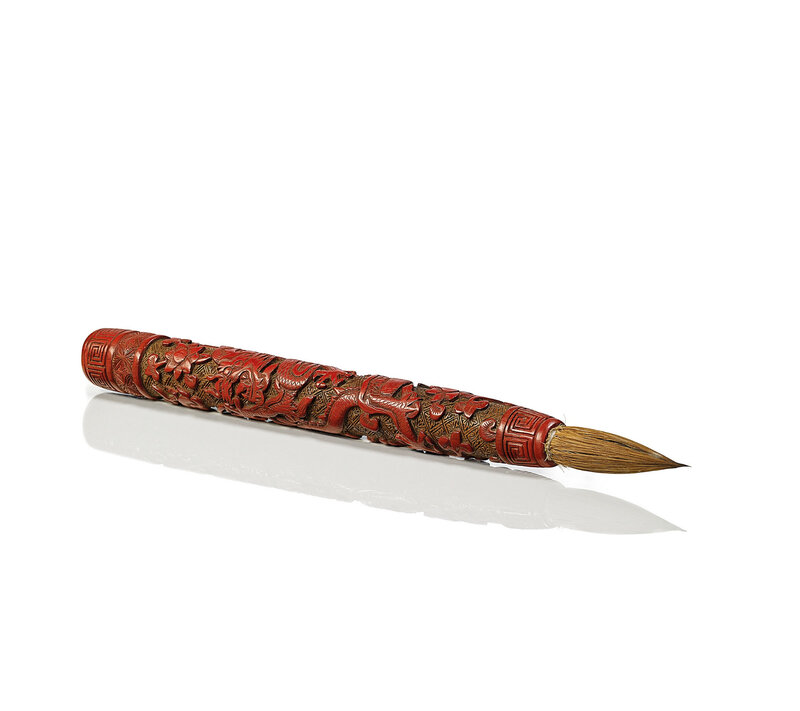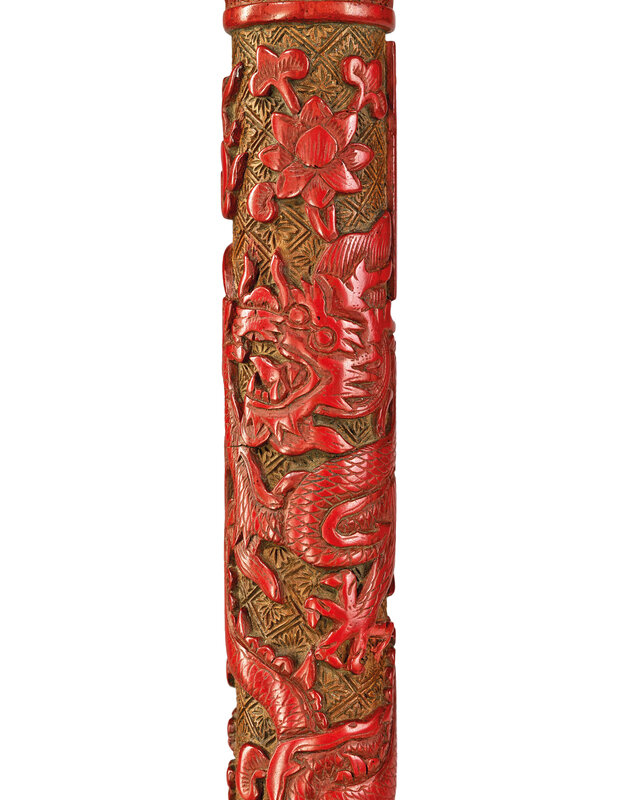Rare et important pinceau impérial en laque rouge et ocre, dynastie Ming, marque et époque Jiajing (1522-1566)
Lot 59. Rare et important pinceau impérial en laque rouge et ocre, Chine, dynastie Ming, marque incisée a six caractères et époque Jiajing (1522-1566). Longueur: 17 cm (6 ¾ in.). Estimate: EUR 50,000 - EUR 70,000. Price realised EUR 112,500. © Christie's Images Ltd 2019.
Il est délicatement sculpté en relief d'un dragon au corps puissant pourchassant la perle sacrée parmi des flammes et nuages sur un fond orné de fleurs stylisées. Les deux extrémités sont agrémentées de frises de grecques. Une marque incisée à six caractères de l'empereur Jiajing est réservée sur un panneau rectangulaire.
A RARE AND IMPORTANT IMPERIAL CARVED TWO-COLOUR LACQUER 'DRAGON' BRUSH, CHINA, QING DYNASTY, JIAJING INCISED SIX-CHARACTER MARK AND OF THE PERIOD (1522-1566)
Note: Carved red lacquer brushes decorated with dragons and bearing a Jiajing reign mark are extremely rare and this present brush appears to be unique.
The only other published example of a carved lacquer and zitan imperial brush with a dragon design and bearing a Jiajing reign mark is in the collection of the Palace Museum, illustrated in The Complete Collection of Treasures of the Palace Museum - 49 - The Four Treasures of the Study - Inksticks and Writing Brushes, Hong Kong, 2005, p. 135, no. 118.
Similar treatment of the reign mark, reserved in a vertical cartouche, can be found on a pair of black ground lacquer Jiajing-marked brushes painted with dragons and pearls, in the National Palace Museum, illustrated in Carving the Subtle Radiance of Colors: Treasured Lacquerware in the National Palace Museum, Taipei, 2008, pl. 94.
The depiction of the five-clawed dragon on the current brush is very close to dragons found on other Jiajing-period lacquerwares. Compare to a carved red lacquer Jiajing-marked circular box decorated with confronted dragon and phœnix and a small red lacquer square tray, also bearing a Jiajing mark, decorated with a dragon and flower design, both in the Beijing Palace Museum Collection, illustrated in Lacquer Wares of the Yuan and Ming Dynasties, The Complete Collection of Treasures of the Palace Museum, Hong Kong, 2006, pl. 175 and pl. 121.
It is interesting to notice that the dragon on the present brush has the fifth claw restored on each foot and we can deduce that they were removed like on numerous other Ming lacquerwares decorated with dragons in the collection of the Palace Museum. The explanation of this phenomenon remains a mystery today. According to J. Watt and B. Ford, East Asian Lacquer; The Florence and Herbert Irving Collection, The Metropolitan Museum of Art, 1991, p. 96, in the entry for no. 34, the removal of one claw from each foot of five-clawed dragons on lacquer and porcelain of the Wanli and Jiajing periods was quite common. This may have been done when a 'palace piece was given by the emperor to a member of the nobility or a senior official and thus "downgraded".
Christie's. Art d'Asie, Paris, 12 Juin 2019

/https%3A%2F%2Fprofilepics.canalblog.com%2Fprofilepics%2F1%2F0%2F100183.jpg)
/https%3A%2F%2Fstorage.canalblog.com%2F03%2F02%2F119589%2F96711876_o.jpg)
/https%3A%2F%2Fstorage.canalblog.com%2F11%2F31%2F119589%2F94773502_o.jpg)
/https%3A%2F%2Fstorage.canalblog.com%2F20%2F83%2F119589%2F94772815_o.jpg)
/https%3A%2F%2Fstorage.canalblog.com%2F26%2F72%2F119589%2F75604929_o.jpg)
/https%3A%2F%2Fstorage.canalblog.com%2F59%2F60%2F119589%2F26458628_o.jpg)





/http%3A%2F%2Fstorage.canalblog.com%2F83%2F47%2F119589%2F128968394_o.jpg)
/http%3A%2F%2Fstorage.canalblog.com%2F21%2F96%2F119589%2F128889109_o.jpg)
/http%3A%2F%2Fstorage.canalblog.com%2F73%2F85%2F119589%2F128812323_o.jpg)
/http%3A%2F%2Fstorage.canalblog.com%2F44%2F60%2F119589%2F128812255_o.jpg)